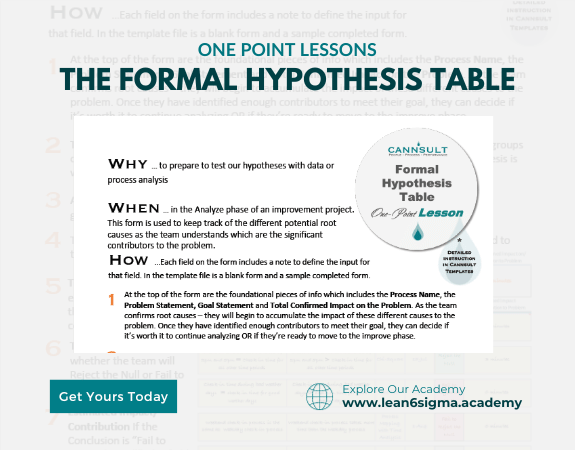Formal Hypothesis Table
Scientific approach
Formulate Hypotheses
Data-driven decision making
Data analysis
Determine variables
The Formal Hypothesis Table is a systematic tool used to formulate, organize, and test hypotheses rigorously, supporting data-driven decision-making and problem-solving.
Description:
The Formal Hypothesis Table is a structured approach to develop and evaluate hypotheses for scientific research, experimentation, or problem-solving. It guides the process of generating hypotheses, determining variables, and conducting tests in a methodical way.
Steps:
Define the Problem: Clearly state the problem or question that needs to be addressed through hypothesis testing.
Generate Hypotheses: Create potential hypotheses that provide explanations or predictions for the problem. Hypotheses should be clear, specific, and testable.
Identify Variables: Determine the independent and dependent variables in each hypothesis. The independent variable is manipulated, while the dependent variable responds to the manipulation.
Formulate Null and Alternative Hypotheses: For each hypothesis, create a null hypothesis (no effect or relationship) and an alternative hypothesis (expected effect or relationship).
Plan Tests or Experiments: Specify the tests, experiments, observations, or data collection methods to test each hypothesis. Ensure the methodology is well-designed and follows scientific principles.
Collect Data: Implement the planned tests or experiments and collect data based on the chosen methodology.
Analyze Results: Use statistical analysis or relevant methods to analyze the collected data and determine whether the results support or reject the null hypothesis.
Draw Conclusions: Based on the analysis, draw conclusions about the hypotheses. Are they supported by evidence? Is the relationship significant?
Reflect on Implications: Consider the implications of the results and how they relate to the original problem or question. This informs decision-making and further actions.
Benefits:
Rigorous hypothesis testing
Structured scientific approach
Data-driven decisions
Methodical problem-solving
Key Takeaway:
The Formal Hypothesis Table is a comprehensive tool for hypothesis formulation, testing, and analysis. It enables rigorous and structured scientific research, experimentation, and problem-solving, leading to informed and data-driven decisions.
Come try it today! It's so easy!

0 Reviews
Riaan is a dynamic leader, coach, facilitator, Lean Six Sigma Master Black Belt with over 20 years of hands-on experience driving business results. Riaan is highly skilled and has worked across diverse industries internationally. With a degree in Chemical Engineering, Riaan started in the major breweries and bakeries in South Africa and was so dedicated to his work that he was often known to take his work home with him.
